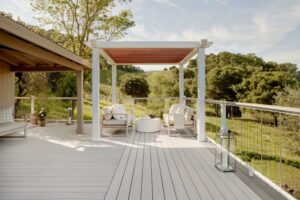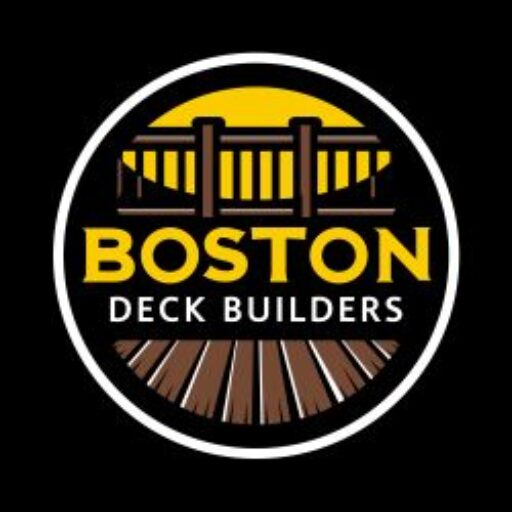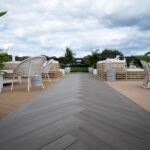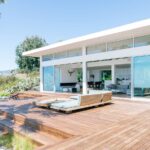A deck doesn’t have to be just a flat platform.
Deck improvements can make it more comfortable, stylish, and useful.
Adding new features to an existing deck can extend its use, create a bug-free chill zone, or boost your home’s value.
You can add new structures to most decks, such as wood decks, pressure-treated wood, and composite decking.
Here are 11 of the most popular deck add-ons that work great in the Greater Boston area.
A screened-in porch is an enclosure built on top of your existing deck.
It uses framed screen panels to keep bugs and debris out while letting in fresh air.
Screened-in porches are a great way to enjoy the outdoors without dealing with mosquitos or harsh sunlight.
Pros:
- Keeps out bugs
- Adds shade and weather protection
- Makes your deck usable in more seasons
Cons:
- Reduces the open-air feel
- Can block some sunlight
- Requires a roof or frame to attach screens
Things to Consider:
You’ll need a solid structure to support the screen panels, especially if your existing deck wasn’t designed for one.
Make sure the screens and framing match your home’s style.
And if you plan to use it in colder months, think about adding insulation or a ceiling fan for air circulation.
A sunroom is a fully enclosed room with windows that’s built over your deck.
It turns your outdoor living space into an indoor extension of your home.
Large windows let in natural light while protecting you from wind, rain, snow, and bugs.
Pros:
- Fully enclosed, so you can use it year-round
- Adds real square footage to your home
- Great for plants, pets, and relaxing in all weather
Cons:
- More expensive than other add-ons
- Might require building permits
- Reduces your outdoor deck space
Things to Consider:
Sunrooms work best when added to larger decks.
You’ll need to check with your town’s building department to make sure you follow local building codes. Every Boston area town is a little different.
A sunroom is a big investment, but it boosts your home’s value and provides usable space year-round.

A pergola is a partial shade structure made of vertical posts and horizontal beams.
It sits above your deck to create a stylish, open-roofed area that adds definition and charm.
Pros:
- Adds shade without fully blocking light
- Looks stylish and adds height to your deck
- Can support vines or string lights for ambiance
Cons:
- Doesn’t protect from rain
- Needs maintenance if built with wood
- Can limit views if not designed well
Things to Consider:
A pergola is a great middle-ground between a fully open and fully covered space.
Add a sun shade for additional sun protection.
In Greater Boston, a pergola needs to handle snow loads or use a removable canopy during winter.
4. Built-In Benches
Built-in benches are permanent seating structures attached directly to your deck’s surface or railing.
They’re a great way to save space while giving everyone a place to sit.
Pros:
- Saves space—no need for bulky outdoor furniture
- Always ready for guests
- Can double as storage (if designed right)
Cons:
- Not as comfy as cushioned patio furniture
- Can’t be moved around
Things to Consider:
Benches are great for families, especially if your deck sees a lot of action during cookouts or parties.
Be sure the design fits the shape and flow of your space.
Adding backrests or cushions can increase comfort.
5. Outdoor Kitchen or Grill Station
An outdoor kitchen or built-in grill station turns your deck into the perfect space for cooking and entertaining.
It can include a built-in grill, sink, mini-fridge, countertops, and even a pizza oven.
Pros:
- Makes entertaining easier and more fun
- Keeps heat and cooking smells outside
- Adds a “wow” factor to your deck
Cons:
- Requires plumbing, gas, or electric connections
- Higher cost and more planning needed
- Needs protection from weather
Things to Consider:
You’ll need to check for utility access and possibly get permits.
Stainless steel appliances hold up better in New England weather.
And don’t forget to plan for ventilation and fire safety, especially if your deck is close to your home.
6. Privacy Walls or Trellises
Privacy walls are vertical structures added to one or more sides of your deck to block views from neighbors.
Trellises offer similar privacy but with open, decorative designs that also support plants.
Pros:
- Blocks views from neighbors
- Shields from wind and harsh sun
- Can double as a space for plants or hanging decor
Cons:
- Might make your deck feel smaller
- Can block airflow if not designed well
Things to Consider:
Privacy walls are especially helpful in tight city or suburban neighborhoods like Somerville or Newton.
You can use wood slats, lattice panels, or even metal screens.
Think about your yard’s layout and sun angles before adding one.
7. Stairs and Multi-Level Design
Adding stairs to your deck allows easy access to your yard.
And creating multiple levels can separate areas for different uses.
They’re a great option for sloped backyards or large outdoor gatherings.
Pros:
- Makes it easier to access your yard
- Adds dimension and flow to your outdoor living space
- Allows for split-use areas (dining above, firepit below)
Cons:
- Can be expensive depending on materials and slope
- Needs deck railings for safety
- May take up more space than expected
Things to Consider:
If your yard slopes, adding stairs can make your deck more functional.
A multi-level layout gives you more design options.
Spiral staircase are gorgeous and can save space for connecting upper and lower deck levels.
But you’ll want to work with a professional deck builder to make sure everything is safe and up to code.
8. Updated or Custom Deck Railings
Railings are an essential safety feature for decks, but they can also be a stylish upgrade.
New railing materials like cable, glass, or aluminum can transform your deck.
Pros:
- Boosts safety and style
- Can modernize the look of an older deck
- Options like glass or cable railings keep views open
Cons:
- Some materials can be pricey
- May require maintenance (especially wood or wrought iron)
Things to Consider:
In the Boston area, snow and rain can cause rust or rot.
So low-maintenance decking materials like vinyl, aluminum, or composite are great choices.
Add flower boxes to railings for space saving ways to add greenery to your space.
Mixing materials—like wood and metal—can give your deck a high-end custom look.
9. Lighting
Deck lighting can include post cap lights, stair lights, string lights, or recessed lights built into the deck floor.
It helps extend the use of your deck into the evening while improving safety and ambiance.
Pros:
- Lets you enjoy your deck after sunset
- Adds safety and visibility
- Creates a cozy, welcoming vibe
Cons:
- Needs electrical setup
- Some lighting options can attract bugs
Things to Consider:
LED deck lights, post caps, and under-rail lighting are popular and energy efficient.
Solar options work too but aren’t always reliable during Boston’s long winters.
Lighting can be easy to install and is an affordable upgrade with a big impact.
10. Adding a Roof or Awning
A roof or awning creates a sheltered area over part or all of your deck.
This turns it into a usable space in almost any weather.
It can be permanent, like a framed roof, or temporary, like a retractable awning.
Pros:
- Full protection from sun, rain, and snow
- Increases shade and comfort
- Makes your deck feel like an outdoor room
Cons:
- Higher cost and construction time
- May need permits and structural support
- Can block natural light inside your home
Things to Consider:
A roof makes your deck more usable in all weather.
You’ll want to think about snow loads, slope, and how the roof connects to your house.
Permanent roofs are great for long-term value, but retractable awnings or shade sails are good seasonal options too.
11. Deck Skirting
Deck skirting is the material that wraps around the bottom of your deck to close off the open space underneath.
It gives your deck a finished look and hides things like support posts, support beams, or stored items.
Common materials include wood slats, lattice panels, or composite deck boards.
Pros:
- Makes your deck look more polished and complete
- Hides the under-deck space for a cleaner yard
- Keeps animals and pests from nesting underneath
- Can be designed to match your deck color and style
Cons:
- Adds to your deck’s overall cost
- May limit airflow if not properly ventilated
- Needs occasional cleaning to prevent mold or mildew
Things to Consider:
If you store items under your deck, consider adding a skirting panel with a hinged door for easy access.
Ventilation is key—especially in the humid Greater Boston climate. So be sure your skirting allows airflow to avoid moisture buildup.
White lattice is a classic timeless option.
For a modern look, go with horizontal composite slats.
Key Takeaways
Adding extra features to your deck is like giving it a personality upgrade.
From outdoor kitchens to year-round living space, there’s something for every homeowner and every budget.
Here in Greater Boston, we deal with changing seasons, salty air (if you’re near the coast), and lots of trees.
So, planning and choosing the right materials ensures your upgrades are built to last.
Want help figuring out which deck add-ons make sense for your home and lifestyle?
Our team of experienced deck builders will inspect your existing deck substructure.
Then walk you through your options and build a custom plan that fits your space.
Ready to Upgrade Your Deck?
Contact us today for a free consultation.





